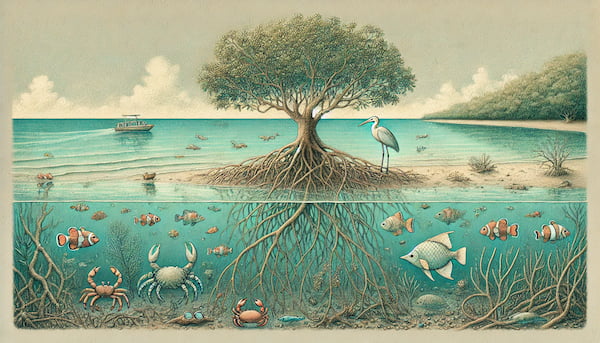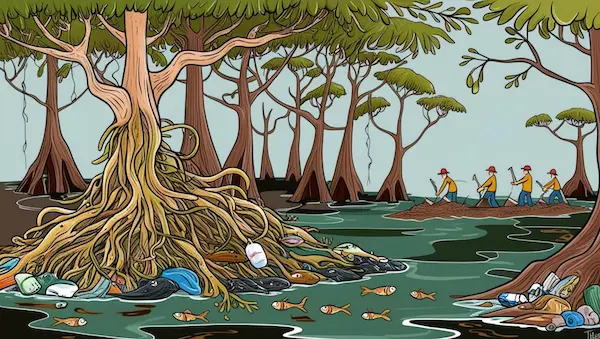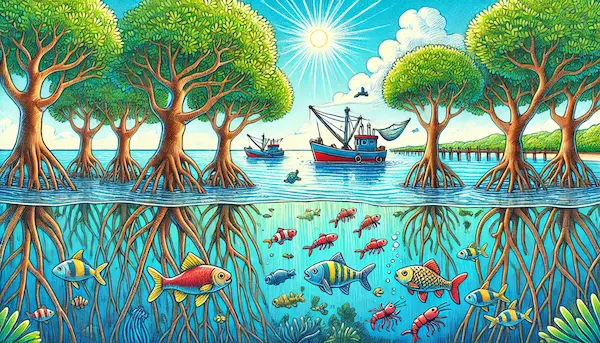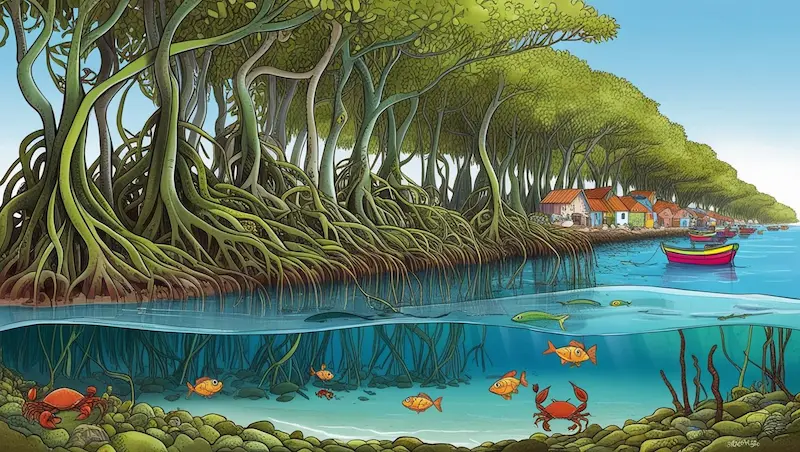Summary
Mangrove forests are unique ecosystems that protect coastlines, nurture marine life, and combat climate change. They act as natural barriers against storms, reduce erosion, and sequester significant carbon. Rich in biodiversity, they support countless species and provide livelihoods to coastal communities. However, mangroves face threats from deforestation, urbanization, and industrial activities. Conservation efforts, community engagement, and innovative research are key to their survival. Learn about their ecological importance, health benefits, and global conservation strategies in our comprehensive guide to safeguarding these vital ecosystems. Explore the role of mangroves in securing a sustainable future for the planet.
Table of Contents
- 1.Introduction
- 2. Ecological Importance
- 3. Mangroves and Climate Change Mitigation
- 4. Threats to Mangrove Ecosystems
- 5. Health and Human Well-being
- 6. Highlighting Conflict Zones
- 7. Link to Global Biodiversity Agreements
- 8. Address Urban Mangroves
- 9. Mangrove Genetics and Research
- 10.Future Outlook and Call to Action
- 11.Conclusion
- 12.References
Introduction
Have you ever walked through a mangrove forest and felt the serenity of nature’s perfect balance? Mangrove trees, with their intertwined roots and thriving biodiversity, are some of Earth’s most unique and vital ecosystems. Yet, these unsung heroes often remain overlooked in global conservation discussions.
What Are Mangroves?
Mangroves are salt-tolerant trees that thrive in coastal intertidal zones, where land and sea embrace. From Southeast Asia’s sprawling mangrove belts to the Caribbean's serene coastlines, these forests are nature’s coastal sentinels, playing a crucial role in preserving marine and terrestrial harmony. Globally, mangroves cover approximately 137,000 square kilometers across 123 countries and territories, making them one of the most critical coastal ecosystems for our planet.
Historical Context
Mangroves have been witnesses to the ebb and flow of history. Indigenous communities have relied on them for food, shelter, and protection against storms. Ancient texts in Southeast Asia reference mangroves as "trees of life," revered for their healing and protective properties. Today, they remain a bridge between history, culture, and modern ecological challenges.
Ecological Importance

Biodiversity Hotspots
Mangroves are bustling hubs of life. Picture a nursery filled with baby fish, crabs, and shrimp, hiding among tangled roots. These ecosystems serve as sanctuaries for countless species, some found nowhere else on Earth. Have you ever imagined how many lives begin in those shadowy waters?
Unique Flora and Fauna
The magic of mangroves lies in their resilience. With leaves that excrete salt and roots that breathe air, mangrove trees have adapted to some of the harshest environments. They’re home to elusive creatures like the mangrove monitor and whimsical fiddler crabs, each playing its part in a delicate web of life.
Coastal Protection
When storms rage and waves roar, mangroves stand as nature’s bulwark. Their dense root systems dissipate wave energy, safeguarding coastlines from erosion and flooding. Isn’t it incredible how trees can protect us better than concrete walls?
Improving Water Quality
Think of mangroves as the Earth's natural filters. They trap sediments and pollutants, ensuring that the waters flowing into oceans are cleaner. This isn’t just good for the environment—it’s vital for the communities that depend on these waters for survival.
Mangroves and Climate Change Mitigation
Carbon Sequestration Abilities
Did you know mangroves are carbon superheroes? They store more carbon per hectare than most terrestrial forests, locking it away in their roots and soil for centuries. This natural carbon sink is a crucial weapon in the fight against global warming. Research shows that mangroves sequester up to four times more carbon per hectare than tropical rainforests, storing an estimated 6.4 billion metric tons of carbon globally.
Comparison to Terrestrial Forests
While rainforests often steal the limelight, mangroves quietly outperform them in carbon storage. Imagine a forest that’s not just above ground but extends below into rich, carbon-packed soils.
Resilience Against Climate Impacts
Mangroves are survivors. Rising seas, shifting tides, and harsh winds—they’ve seen it all. This resilience makes them not just survivors but allies in a world grappling with climate uncertainty.
Threats to Mangrove Ecosystems

Deforestation and Habitat Loss
Mangroves are disappearing at an alarming rate. Coastal development and logging carve away these forests, leaving vulnerable coastlines in their wake. Every fallen tree is a lost protector for communities and marine life. Between 1980 and 2005, approximately 20% of the world’s mangroves were lost, and this trend continues at an alarming rate of 0.16% annually
Pollution and Degradation
Plastic waste, industrial runoff, and oil spills—these are just some of the enemies mangroves face. Each pollutant weakens their ability to support life and maintain balance.
Climate Change and Rising Sea Levels
Rising seas may drown mangrove habitats faster than they can adapt. These forests are on the frontlines of climate change, and their loss would ripple across ecosystems globally.
Health and Human Well-being
Imagine a world without mangroves. Not just coastal flooding, but a loss of natural pharmacies and clean water. Did you know mangroves harbor a treasure trove of medicinal plants? From antiviral compounds to cancer-fighting properties, their leaves, bark, and roots are being explored by researchers worldwide.
Beyond their medicinal potential, mangroves act as nature’s filters. They purify water, trap pollutants, and even improve air quality. Coastal communities often recount how healthier mangroves mean fewer illnesses, better drinking water, and thriving fisheries.
Here’s an astonishing fact: according to a study published in *Nature Communications*, mangrove forests prevent over $65 billion in damages annually by reducing storm surges and flooding. That’s not just science—it’s survival for millions of vulnerable communities.
Highlighting Conflict Zones

Picture this: an oil rig looming over a mangrove-lined coast. The tension is palpable. Industrial expansion has put these delicate ecosystems at risk, especially in regions like Southeast Asia and West Africa. Shrimp farming, oil exploration, and urban sprawl often clash with conservation goals.
Take Indonesia, for instance, where mangrove forests are cleared at alarming rates for aquaculture. A report by *The Guardian* highlighted that nearly 40% of mangrove losses globally stem from such practices. Yet, it’s not all gloom. Local NGOs and community activists are rallying to find middle ground. Could eco-certifications or sustainable farming be the answer?
Link to Global Biodiversity Agreements

When you save a mangrove forest, you contribute to global biodiversity goals. How? Mangroves are champions of the Convention on Biological Diversity (CBD), aligning with the Aichi Targets and the Kunming-Montreal Global Biodiversity Framework.
Statistics reveal their critical role: mangroves support 75% of tropical commercial fish species during some stage of their lifecycle. That’s not just biodiversity; it’s the backbone of global fisheries. Could protecting mangroves be the simplest way to achieve these international targets?
Address Urban Mangroves
Mangroves in cities? It’s more common than you think. Urban mangroves, such as those in Mumbai or Jakarta, act as green lungs in concrete jungles. They reduce urban heat, absorb pollutants, and provide recreational spaces for city dwellers.
Despite their importance, these mangroves are disappearing rapidly. A *UN Habitat* report highlighted that urban mangroves shrink by 1% annually due to land reclamation and waste dumping. But hope is not lost. Projects like the Navi Mumbai Mangrove Board are showing the way by integrating mangroves into urban planning.
Mangrove Genetics and Research
Did you know mangroves hold secrets to surviving climate extremes? Genetic research is uncovering how these resilient plants adapt to salinity, flooding, and heat. Such studies are vital as we face a warming world.
In 2023, researchers from *Nature Ecology & Evolution* sequenced the genome of the black mangrove (*Avicennia germinans*), revealing genes responsible for salt tolerance. These findings are not just academic—they’re paving the way for reforestation projects in challenging environments.
Future Outlook and Call to Action
What does the future hold for mangroves? The stakes have never been higher. Experts predict that without immediate action, we could lose up to 20% of mangrove cover by 2050. But there’s hope. From AI-powered monitoring systems to community-led planting drives, innovation is leading the way.
We need policies that prioritize long-term gains over short-term profits. Let’s amplify voices from coastal communities and scientists who’ve dedicated their lives to these ecosystems. Remember, every mangrove saved is a step toward a healthier planet.
Frequently Asked Questions
1. What are mangrove forests, and where are they found?
Mangrove forests are unique coastal ecosystems consisting of salt-tolerant trees and shrubs that thrive in intertidal zones. They are predominantly found in tropical and subtropical regions, such as Southeast Asia, Africa, and the Americas. Notable locations include the Sundarbans in India and Bangladesh, the Florida Everglades, and Brazil's coastline.
2. Why are mangrove forests important for the environment?
Mangrove forests are essential for stabilizing coastlines, preventing erosion, and reducing the impact of storm surges. They act as natural carbon sinks, storing up to four times more carbon per hectare than tropical rainforests. Additionally, they provide critical habitats for marine and terrestrial species.
3. How do mangroves protect against climate change?
Mangroves mitigate climate change by sequestering large amounts of carbon dioxide in their biomass and soil. They also serve as buffers, protecting coastal communities from rising sea levels, storm surges, and extreme weather events.
4. What are the threats to mangrove forests?
Mangroves face numerous threats, including deforestation for aquaculture, agriculture, and urban development. Climate change, rising sea levels, and pollution further exacerbate their decline. According to *The Guardian*, nearly 40% of global mangrove loss is due to aquaculture and shrimp farming.
5. Can mangroves be restored?
Yes, mangroves can be restored with proper planning and community involvement. Restoration projects often involve planting native mangrove species, protecting degraded areas, and implementing sustainable land-use practices. Notable success stories include the Philippines' community-led mangrove reforestation programs.
6. How do mangroves support marine life?
Mangroves are nurseries for various marine species, providing shelter and food for fish, crabs, and mollusks. They are also home to migratory birds, reptiles, and mammals, making them hotspots of biodiversity.
7. What can individuals do to help conserve mangrove forests?
Individuals can support mangrove conservation by participating in tree-planting initiatives, reducing their carbon footprint, and advocating for sustainable coastal policies. Donating to organizations working on mangrove conservation is another effective way to make a difference.
Conclusion
Mangroves are more than trees. They’re lifelines for biodiversity, shields against climate impacts, and sources of inspiration. Their story is our story—a tale of resilience, interdependence, and hope.
Now, the choice is ours. Will we stand by as they disappear, or will we act? Let’s ensure that mangroves thrive, not just for the planet, but for future generations who deserve to witness their beauty and bounty.
References
1. Nature Communications: Mangroves’ Role in Flood Prevention
2. The Guardian: Mangrove Loss and Restoration
3. UNEP Reports on Biodiversity and Urban Mangroves
5. UNEP (United Nations Environment Programme) highlights the unique ecosystem mangroves, Available at: UNEP (United Nations Environment Programme) highlights on Mangrove Forests
6. UNEP notes the vital role of mangroves. Learn more at: Beauty and benefits of Mangroves



